Wireless Channel Generation for Outdoor Mobile User Connected to Rural Macro Site
Objective
Generate Channel for Mobile users
Variation in power with time.
In this tutorial, we will learn how to generate a channel for mobile users and analyze how the power received by users moving vary over time.
To set up a simulation, we consider a layout having a 3 sector Hexagonal geometry, where the Base Stations are located at the center of hexagon covering each sector and a single User Equipment (UE) moving on a circular trajectory.
We choose RuralMacro (RMa) terrain with a carrier frequency of 3 GHz for simulation.
We also choose omni directional dipole antenna for Receiver (Rx) and a parabolic antenna for Transmitter (Tx).
We first import the necessary libraries followed by creating objects of classes
AntennaArrays,NodeMobility, andSimulationLayoutrespectively
The content of the tutorial is as follows:
Table Of Content
Import Libraries
Python Libraries
[1]:
import os
os.environ["CUDA_VISIBLE_DEVICES"] = "-1"
os.environ['TF_CPP_MIN_LOG_LEVEL'] = '3'
# %matplotlib widget
import matplotlib.pyplot as plt
import matplotlib.patches as patches
import matplotlib.animation as animation
import numpy as np
5G Toolkit Libraries
[2]:
# importing necessary modules for simulating channel model
import sys
sys.path.append("../../../")
from toolkit5G.ChannelModels import NodeMobility
from toolkit5G.ChannelModels import AntennaArrays
from toolkit5G.ChannelModels import SimulationLayout
[3]:
# from IPython.display import display, HTML
# display(HTML("<style>.container { width:100% !important; }</style>"))
Simulation Parameters
Define the following Simulation Parameters:
propTerraindefines propagation terrain for BS-UE linkscarrierFrequencydefines carrier frequency in HznBSsdefines number of Base Stations (BSs)nUEsdefines number of User Equipments (UEs)nSnapShotsdefines number of SnapShots, where SnapShots correspond to different time-instants at which a mobile user channel is being generated.
[4]:
# Simulation Parameters
propTerrain = "RMa" # Propagation Scenario or Terrain for BS-UE links
carrierFrequency = 3.6*10**9 # carrier frequency in Hz
nBSs = 3 # number of BSs
nUEs = 1 # number of UEs
nSnapShots = 60 # number of SnapShots
Antenna Arrays
Antenna Array at Rx
The following steps describe the procedure to generate AntennaArrays Objects at a single carrier frequency both at Tx and Rx side:
Choose an omni directional dipole antenna for Rx, for which we have to pass the string “OMNI” while instantiating
AntennaArraysclass.Pass
arrayStructureof[1,1,2,2,1]meaning 1 panel in vertical direction, 1 panel in horizonatal direction, 2 antenna elements per column per panel, 2 columns per panel and 1 correspond to antenna element being single polarized.For this antenna structure, the number of Rx antennas
Nrto be 4.
[5]:
# Antenna Array at UE side
# antenna element type to be "OMNI"
# with single panel and 4 single polarized antenna element per panel.
bsAntArray = AntennaArrays(antennaType = "3GPP_38.901",
centerFrequency = carrierFrequency,
arrayStructure = np.array([1,1,2,2,1]))
bsAntArray()
# num of Rx antenna elements
nt = bsAntArray.numAntennas
# Radiation Pattern of Rx antenna element
bsAntArray.displayAntennaRadiationPattern()
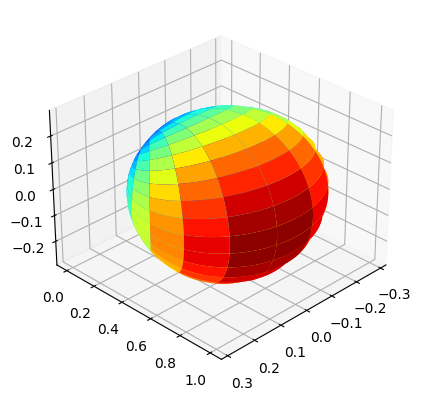
[5]:
(<Figure size 960x480 with 1 Axes>, <Axes3D: >)
[6]:
# Antenna Array at UE side
# antenna element type to be "OMNI"
# with single panel and 4 single polarized antenna element per panel.
ueAntArray = AntennaArrays(antennaType = "OMNI",
centerFrequency = carrierFrequency,
arrayStructure = np.array([1,1,2,2,1]))
ueAntArray()
# num of Rx antenna elements
nr = ueAntArray.numAntennas
# Radiation Pattern of Rx antenna element
ueAntArray.displayAntennaRadiationPattern()
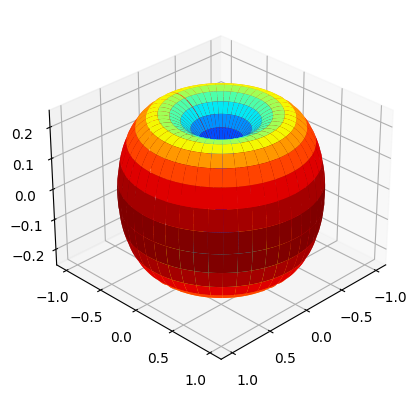
[6]:
(<Figure size 960x480 with 1 Axes>, <Axes3D: >)
Antenna Array at Tx
We choose a parabolic antenna for Tx, for which we have to pass the string
"3GPP_38.901"while instantiatingAntennaArraysclass.We pass
arrayStructureof[1,1,2,4,2]meaning 1 panel in vertical direction, 1 panel in horizonatal direction, 2 antenna elements per column per panel, 4 columns per panel and 2 correspond to antenna element being dual polarized.With this structure, we obtain number of Tx antennas
ntto be 16.
[7]:
# Antenna Array at BS side
# antenna element type to be "3GPP_38.901", a parabolic antenna
# with single panel and 8 dual polarized antenna element per panel.
ue2AntArray = AntennaArrays(antennaType = "3GPP_38.901",
centerFrequency = carrierFrequency,
arrayStructure = np.array([1,1,2,4,2]))
ue2AntArray()
# num of Tx antenna elements
nt = ue2AntArray.numAntennas
# Radiation Pattern of Tx antenna element
ue2AntArray.displayAntennaRadiationPattern()
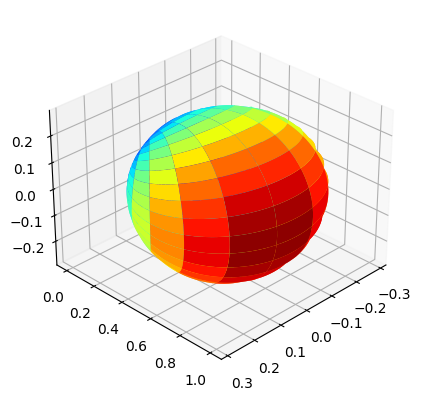
[7]:
(<Figure size 960x480 with 1 Axes>, <Axes3D: >)
Node Mobility
Generate the route/trajectory for the mobile UE:
All the Base Stations (BSs) are considered to be static and the User Equipments (UE) is mobile.
The UE is moving at 0.833 m/s (3 kmph) on a circular trajectory of radius 250 meter centered around origin.
For the UE, 60 snapshots are drawn while in motion on the circle with an interval of 5 sec.
The parameters are selected such that the UE complete the circumference of the circle.
[8]:
# NodeMobility parameters
# assuming that all the BSs are static and all the UEs are mobile.
# time values at each snapshot.
isInitLocationRandom = True # Initial location of the UE is random.
initAngle = None # Not required when isInitLocationRandom is True.
isInitOrientationRandom = False # UE Orientations are UE. Not randomized.
snapshotInterval = 5 # 5 second
speed = 0.833 # speed of the UE 3 Kmph
radius = 250 # 3 Kmph
timeInst = snapshotInterval*np.arange(nSnapShots, dtype=np.float32)
UEroute = NodeMobility("circular", nUEs, timeInst, radius, radius,
speed, speed, isInitLocationRandom, initAngle,
isInitOrientationRandom)
UEroute2 = NodeMobility("circular", nUEs, timeInst, radius, radius,
speed, speed, isInitLocationRandom, initAngle,
isInitOrientationRandom)
UEroute()
fig, ax = UEroute.displayRoute()
ax.set_aspect(True)
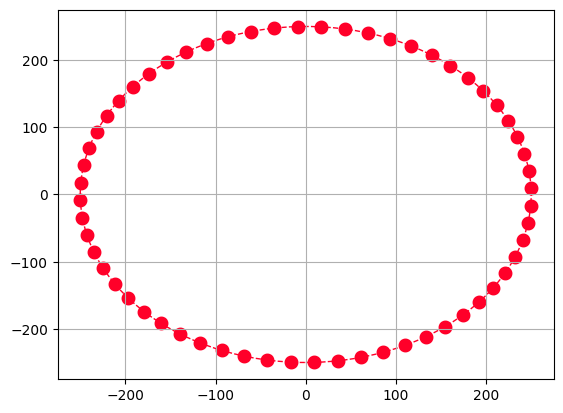
Simulation Layout
We define the simulation topology parametes:
ISD: Inter Site DistanceminDist: Minimum distance between transmitter and receiver.bsHt: BS heightsueHt: UE heightstopology: Simulation TopologynSectorsPerSite: Number of Sectors Per Site
Furthermore, users can access and update following parameters as per their requirements for channel using the handle simLayoutObj.x where x is:
The following parameters can be accessed or updated immendiately after object creation
UEtracksUELocationsueOrientationUEvelocityVectorBStracksBSLocationsbsOrientationBSvelocityVector
The following parameters can be accessed or updated after calling the object
linkStateVec
[9]:
# Layout Parameters
isd = 500 # inter site distance
minDist = 35 # min distance between each UE and BS
ueHt = 1.5 # UE height
bsHt = 35 # BS height
topology = "Hexagonal" # BS layout type
nSectorsPerSite = 3 # number of sectors per site
memoryEfficient = False
enableSpatialConsistencyLoS = True
enableSpatialConsistencyIndoor = True
print(" enableSpatialConsistency: "+str(enableSpatialConsistencyLoS))
print(" memoryEfficient: "+str(memoryEfficient))
print("enableSpatialConsistencyIndoor: "+str(enableSpatialConsistencyIndoor))
# simulation layout object
simLayoutObj = SimulationLayout(numOfBS = nBSs,
numOfUE = nUEs,
heightOfBS = bsHt,
heightOfUE = ueHt,
ISD = isd,
layoutType = topology,
numOfSectorsPerSite = nSectorsPerSite,
ueRoute = UEroute,
memoryEfficient = memoryEfficient,
enableSpatialConsistencyLoS = enableSpatialConsistencyLoS,
enableSpatialConsistencyIndoor = enableSpatialConsistencyIndoor)
# Update UE location for motion over a circle centered around the BS location.
simLayoutObj.UELocations = -simLayoutObj.UEtracks.mean(0)
simLayoutObj(terrain = propTerrain,
carrierFreq = carrierFrequency,
ueAntennaArray = ueAntArray,
bsAntennaArray = bsAntArray,
forceLOS = False)
# displaying the topology of simulation layout
fig, ax = simLayoutObj.display2DTopology()
ax.scatter(simLayoutObj.UELocations[0,0]+simLayoutObj.UEtracks[:,0,0],
simLayoutObj.UELocations[0,1]+simLayoutObj.UEtracks[:,0,1],
color="k", label = "NLoS Instants", zorder=-1)
ax.scatter(simLayoutObj.UELocations[0,0]+simLayoutObj.UEtracks[simLayoutObj.linkState[:,0,3],0,0],
simLayoutObj.UELocations[0,1]+simLayoutObj.UEtracks[simLayoutObj.linkState[:,0,3],0,1],
color="r", label = "LoS Instants", zorder=-1)
ax.scatter(simLayoutObj.UELocations[0,0],simLayoutObj.UELocations[0,1], color="b", label = "UE-InitialLocation", zorder=0)
ax.set_xlabel("x-coordinates (m)")
ax.set_ylabel("y-coordinates (m)")
ax.set_title("Simulation Topology")
ax.legend()
# plt.show()
enableSpatialConsistency: True
memoryEfficient: False
enableSpatialConsistencyIndoor: True
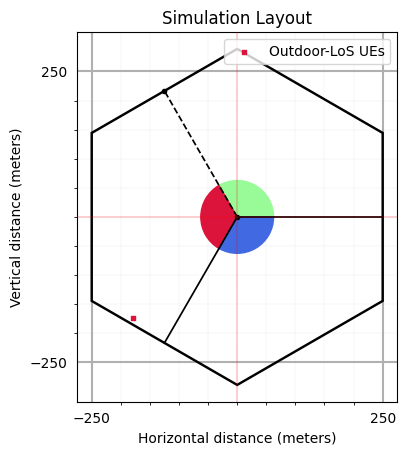
[9]:
<matplotlib.legend.Legend at 0x7f7940973750>
Channel Parameters, Channel Coefficients and OFDM Channel
The user can access the channel coefficents and other parameters using following handles:
LSPs/SSPs: paramGenObj.x where x is
linkStateVecdelaySpreadphiAoA_LoS,phiAoA_mn,phiAoA_spreadthetaAoA_LoS,thetaAoA_mn,thetaAoA_spreadphiAoD_LoS,phiAoD_mn,phiAoD_spreadthetaAoD_LoS,thetaAoD_mn,thetaAoD_spreadxprpathloss,pathDelay,pathPowershadowFading
Channel Co-efficeints: channel.x where x is
coefficientsdelays
Shape of OFDM Channel:
Hfis of shape :(number of carrier frequencies, number of snapshots, number of BSs, number of UEs, Nfft, number of Rx antennas, number of Tx antennas)
[10]:
# Generate SSPs/LSPs Parameters:
paramGenObj = simLayoutObj.getParameterGenerator(memoryEfficient = True,
enableSpatialConsistencyForLSPs = True,
enableSpatialConsistencyForSSPs = True,
enableSpatialConsistencyForInitialPhases = True)
# Generate Channel Coefficeints and Delays: SSPs/LSPs
channel = paramGenObj.getChannel(applyPathLoss = True)
# Channel coefficients can be accessed using: channel.coefficients
# Channel delays can be accessed using: channel.delays
# Generate OFDM Channel
Nfft = 1024
Hf = channel.ofdm(30*10**3, Nfft, simLayoutObj.carrierFrequency)
[Warning]: UE height 'hUE' cannot be less than 1! These values are forced to 1!
dBP (min, max): 2638.93798828125, 2638.93798828125
[Warning]: UE height 'hUE' cannot be less than 1! These values are forced to 1!
dBP (min, max): 2638.93798828125, 2638.93798828125
[11]:
Hf.shape
[11]:
(1, 60, 3, 1, 1024, 4, 4)
Variation in Channel Power across Time
The following code snippets displays the variation of received power of a UE when moves on a circular track (centered around origin) starting from its
initial position.In the current simulation we have 3 BSs and 1 UE moving on a circular track starting from a random intitial position inside a hexagonal layout.
[12]:
fig, ax = plt.subplots()
power = 10*np.log10(((np.abs(Hf)**2).sum(axis=0).sum(axis=2).sum(axis=2).sum(axis=2).sum(axis=2))/(nr*nt))
colors = np.array(['palegreen', 'crimson','royalblue'])
ax.plot(timeInst, power[:,0], colors[0], label = "BS-0")
ax.plot(timeInst, power[:,1], colors[1], label = "BS-1")
ax.plot(timeInst, power[:,2], colors[2], label = "BS-2")
ax.legend()
ax.grid()
ax.set_xlabel('Time Instances (sec)')
ax.set_ylabel('Received-Power (dB)')
ax.set_title('Received-Power Variation With Time', fontsize=12)
plt.show()
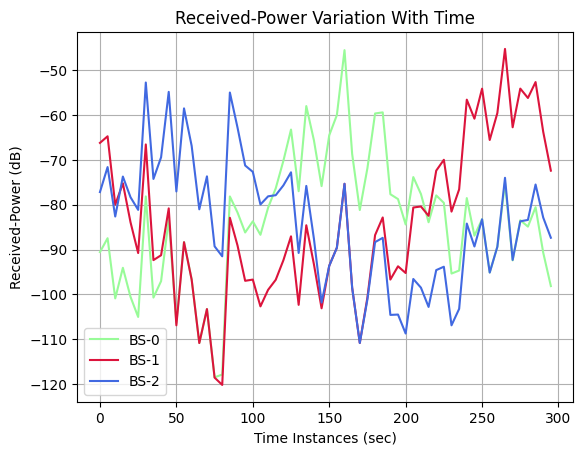
Animation: Displaying the variation in receiver power of a UE time snapshots
Discalimer : This animation requires the intractive matplotlib.
Functions to Animate the Plot
[13]:
def wrapTo30(ang):
# Function to wrap angles not exceeding 30 degree.
ang = np.mod(ang, np.pi/3)
return np.where(ang>np.pi/6, ang-np.pi/3, ang)
def plotLayout(ax):
scale = 8
colors = np.array(['palegreen', 'crimson', 'royalblue', 'gold', 'midnightblue', 'purple','orange','lightcoral'])
delAngle = 360/nSectorsPerSite
numSites = int(nBSs/nSectorsPerSite)
simLayoutObj.BSLocations
mark = ['c--', 'm:', 'y-']
# Add some coloured hexagons
for idx in range(numSites):
# color = c[0]
hex = patches.RegularPolygon((simLayoutObj.BSLocations[0,idx], simLayoutObj.BSLocations[1,idx]), numVertices=6,
radius=isd/np.sqrt(3),orientation=np.radians(120),
facecolor = 'none',alpha=1, edgecolor='k', lw = 1.75)
ax.add_patch(hex)
# Also add a text label
for n in range(nSectorsPerSite):
sector = patches.Wedge((simLayoutObj.BSLocations[0,idx], simLayoutObj.BSLocations[1,idx]), # (x,y)
isd/scale, # radius
n*delAngle, # theta1 (in degrees)
(n+1)*delAngle, # theta2
color=colors[n%8],
alpha=1)
ax.add_patch(sector)
if(nSectorsPerSite != 1):
boundDistance = isd*np.sqrt(5/12-(1/6)*np.abs(np.cos(2*wrapTo30(n*delAngle*np.pi/180))))
ax.plot([simLayoutObj.BSLocations[0,idx], simLayoutObj.BSLocations[0,idx] + boundDistance*np.cos(n*delAngle*np.pi/180)],
[simLayoutObj.BSLocations[1,idx], simLayoutObj.BSLocations[1,idx] + boundDistance*np.sin(n*delAngle*np.pi/180)],
mark[n%3], lw=2, label = "Sector "+ str(n) + "-->"+str((n+1)%3) + " Boundary")
# function that draws each frame of the animation
def animate(i):
x.append(timeInst[i])
y0.append(power[:,0][i])
y1.append(power[:,1][i])
y2.append(power[:,2][i])
ax[0].clear()
ax[0].grid()
ax[0].plot(x, y0, color='palegreen')
ax[0].plot(x, y1, color='crimson')
ax[0].plot(x, y2, color='royalblue')
ax[0].set_xlim([0, timeInst[-1]])
ax[0].set_ylim([-120,-70])
# ax[0].margins(x=0, y=-0.25) # Values in (-0.5, 0.0) zooms in to center
ax[0].scatter(timeInst[i], power[:,0][i], color ='palegreen', label = "Received-Power from BS-0")
ax[0].scatter(timeInst[i], power[:,1][i], color ='crimson', label = "Received-Power from BS-1")
ax[0].scatter(timeInst[i], power[:,2][i], color ='royalblue', label = "Received-Power from BS-2")
ax[0].axvline(x = timeInst[6], color ='c', ls = "--", lw = 2, label = "Sector 0-->1 Boundary")
ax[0].axvline(x = timeInst[26], color ='m', ls = ":", lw = 2, label = "Sector 1-->2 Boundary")
ax[0].axvline(x = timeInst[46], color ='y', lw = 2, label = "Sector 2-->0 Boundary")
ax[0].set_xlabel('Time Instances (sec)')
ax[0].set_ylabel('Received-Power (dB)')
ax[0].set_title('Received-Power Variation With Time', fontsize=12)
ax[0].legend()
ax[1].clear()
ax[1].grid()
ax[1].scatter(simLayoutObj.UELocations[0,0]+simLayoutObj.UEtracks[0:i,0,0],
simLayoutObj.UELocations[0,1]+simLayoutObj.UEtracks[0:i,0,1], color="k", zorder=-1, label = "UE's Past Locations")
ax[1].scatter(simLayoutObj.UELocations[0,0]+simLayoutObj.UEtracks[i,0,0],
simLayoutObj.UELocations[0,1]+simLayoutObj.UEtracks[i,0,1], color="r", zorder=-1, label = "UE's Current Locations")
ax[1].scatter(simLayoutObj.UELocations[0,0],simLayoutObj.UELocations[0,1], color="b", zorder=-1, label = "UE's Start Loaction")
plotLayout(ax[1])
ax[1].set_xlabel('x-coordinates (m)')
ax[1].set_ylabel('y-coordinates (m)')
ax[1].set_title('Simulation Layout', fontsize=12)
ax[1].legend()
ax[1].set_xlim([-300, 300])
ax[1].set_ylim([-300, 300])
# ax[1].margins(x=0, y=-0.25) # Values in (-0.5, 0.0) zooms in to center
Simulation Animation
Note: Please uncomment the %matplotlib widget to run the animation.
[14]:
# create the figure and axes objects
scaleFig = 1.75
fig, ax = plt.subplots(1,2,figsize=(17.5/scaleFig,7.5/scaleFig))
fig.suptitle('Simulation of Node Mobility', fontsize=10)
# ax[0].set_aspect('equal')
# ax[1].set_aspect('equal')
# create empty lists for the x and y data
x = []
y0 = []
y1 = []
y2 = []
#####################
# run the animation
#####################
# frames= 20 means 20 times the animation function is called.
# interval=500 means 500 milliseconds between each frame.
# repeat=False means that after all the frames are drawn, the animation will not repeat.
# Note: plt.show() line is always called after the FuncAnimation line.
anim = animation.FuncAnimation(fig, animate, frames=timeInst.shape[0], interval=500, repeat=False, blit=True)
# saving to mp4 using ffmpeg writer
# writervideo = animation.FFMpegWriter(fps=30)
# anim.save('SimulationOfNodeMobility.mp4', writer=writervideo)
# anim.save('SimulationOfNodeMobility.mp4', fps=30, extra_args=['-vcodec', 'libx264'])
# anim.save("mobility.gif", fps = 2)
# plt.show()
[15]:
# anim = animation.FuncAnimation(fig, animate, frames=timeInst.shape[0], interval=500, repeat=False, blit=True)
# anim.save("mobility.gif", fps = 2)
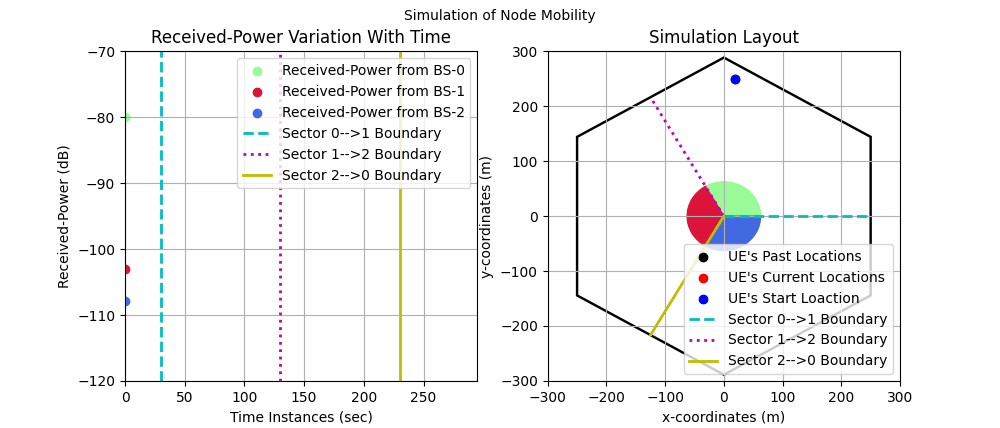
Further Study
Simulate by increasing number of UEs
nUEsgreater than 1 and see how the power varies with time for each mobile user.Increase number of carrier frequencies to be grater than 1 and see how carrier frequency effects the power.
Simulate the same channel for
NLOSlinks as well by makingforceLOS = Falseand see how the performance change.
[ ]: